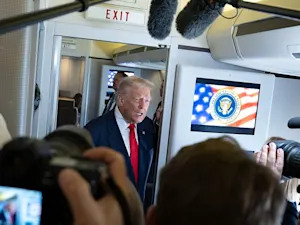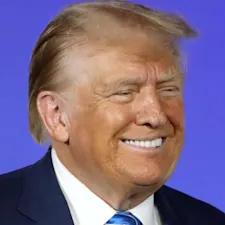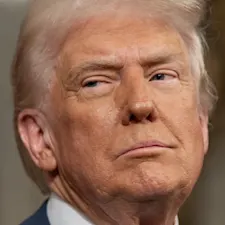
Empty Store Shelves Are Coming: What to Buy Before It's Too Late
Empty toilet paper shelves during the COVID-19 pandemic, 2020. Photo by Dan Keck under CC0 1.0.
It could happen faster than you think. Shoppers could soon find themselves staring at half-empty store shelves, hunting for essentials like electronics, sneakers, and holiday toys — and coming up short.
The warning signs are already flashing red.
Massive tariffs on Chinese goods, newly imposed by President Donald Trump, are sending shockwaves through America's supply chain. Experts say the next few weeks could mark a repeat of the dreaded 2020 pandemic shortages — but this time, it could hit even harder and across many more aisles.
A New Supply Chain Crisis
Retailers across the U.S. are scrambling. Shipments from China have plummeted, with the number of freight vessels scheduled to dock at the Port of Los Angeles expected to drop by 33% compared to last year for the week ending May 10, NBC News reports.
At the center of the storm: a 145% tariff on nearly all Chinese imports. This means that for every $100 item imported, businesses must now fork over $145 more to bring it into the country. Electronics and pharmaceuticals have been slightly spared with lower rates, but almost everything else — from toys to tennis shoes — is slammed with the new cost.
Why You Should Care
The last time store shelves went bare was during the early months of the COVID-19 pandemic. Then, it was toilet paper and hand sanitizer. This time, it's poised to be everyday staples and gift-season must-haves. Products like back-to-school clothes, affordable sneakers, holiday toys, and even kitchen appliances are in the crosshairs.
And it's not just low-cost goods. Major chains like Walmart® and Target® are already reporting delayed shipments, canceled orders, and higher prices looming on the horizon.
What Exactly Is a Tariff?
A tariff is a tax that the government charges on goods coming into the country. In this case, it's aimed at imports from China. Businesses either absorb the new costs (and lose money) or pass them on to you, the consumer. In most cases, companies have no choice but to raise prices, meaning you'll pay more at checkout.
Tariffs are meant to level the playing field between countries with imbalanced trade practices — but they can backfire, hitting consumers hardest.
How Long Could This Last?
Even if the administration eases up tomorrow, the damage is already baked in for the next several months.
Supply chains are like ocean liners — they can't turn on a dime. Retailers made their holiday buying decisions this spring. If orders were canceled, replacements won't magically appear.
If tariffs continue at their current levels, experts expect inventory shortages to worsen through the summer and fall, with some predicting the pain could last well into the second half of 2025.
What Items Will Get Hit First?
Retail experts warn that specific categories are especially vulnerable:
- Clothing and Shoes: Lower-cost apparel and sneakers are heavily sourced from China, with footwear imports from China accounting for about 58% of U.S. supply in 2024, as reported by CNBC.
- Toys: From Barbie® dolls to Hot Wheels®, many popular brands rely on Chinese factories.
- Electronics: Smartphones, TVs, laptops, and kitchen gadgets, even if final assembly happens elsewhere, often have Chinese-made parts.
- Small Appliances: Microwaves, air fryers, blenders, and coffee makers are expected to skyrocket in price.
- Household Goods: Everything from cheap furniture to light fixtures could become harder to find.
- Food Items: Perishable imports like apple juice concentrate and frozen fish could also see supply disruptions.
What Should You Buy Right Now?
Experts recommend focusing on essentials you know you'll need in the next 6–12 months — especially big-ticket items:
- Electronics: Phones, laptops, earbuds, TVs.
- Appliances: Microwaves, dishwashers, washing machines.
- Footwear and Apparel: Basics like sneakers, socks, and back-to-school clothes.
- Toys: Birthday and holiday gifts.
- Coffee and Wine: If you love a morning brew or a good Cabernet, prices could spike soon.
On the flip side, experts say there's no need to panic-buy luxury items or random non-essentials. Focus on what matters to your household.
How Will You Feel It?
In the coming months, you may notice:
- Fewer choices on store shelves.
- Steeper prices for everyday products.
- Delays when ordering popular items online.
- Holiday shopping frustration if you wait too long.
And if you're wondering whether the tariffs will be rolled back soon — that's anyone's guess. According to NBC News, President Trump said he was "considering" tariff reductions after meeting with major retailers, but no formal moves have been made yet.
For now, the safest bet is to act like a savvy shopper: think ahead, buy smart, and beat the rush while shelves are still stocked.
References:Product shortages and empty store shelves loom with falling shipments from China | Shoppers to see empty shelves in just weeks as experts reveal which retailers will be first to 'run out of inventory' | The trade war's wave of retail shortages will hit U.S. consumers in stages. Here's when | Concerned about tariffs? The items experts say you should be buying now






















